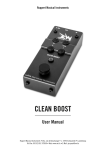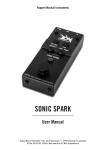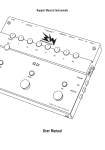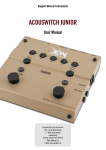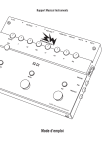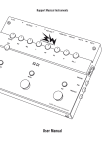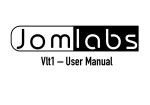Download Basswitch Classic Boost Manual
Transcript
Ruppert Musical Instruments CLASSIC BOOST User Manual Ruppert Musical Instruments • 20a, rue de Bascharage • L - 4995 Schouweiler • Luxembourg Tel./Fax: 00 352 691 379050 • Web: www.rmi.lu • E-Mail: [email protected] Congratulations! With the Basswitch Classic Boost you have purchased a super compact high-end bass preamp gently voiced for passive P, JJ and PJ type basses that gives you the confidence to be adequately prepared for any situation, be it in a live performance or in a recording studio. carefully so that you can consult it at any time. Your Basswitch Classic Boost package contains the following items: - Basswitch Classic Boost - User manual When developing the Basswitch Classic Boost we focused on the needs and wishes of the professional bass player who is not willing to compromise on either sound or the technical quality of the equipment. The Basswitch Classic Boost is manufactured, assembled and tested in Germany to the highest quality standards using only the best brand components available to ensure optimal treatment of the electrical signal from your instrument. Please check that all these items are there as soon as you unpack. Should something be missing, please contact your authorised dealer. The Basswitch Classic Boost is built to last, but if you nonetheless experience problems or have any questions do not hesitate to contact us. Please take your time to read this user manual carefully before you start using your Basswitch Classic Boost. You will find lots of useful information on the pedal and the various ways it can be used. Keep this user manual I wish you every success with your Basswitch Classic Boost. Yours, Jacques Ruppert Summary Introduction2 Description2 Tech Talk 3 Technical data 4 Introduction Why a specific Booster for bass instruments? The reasons are obvious: the frequency range of bass instruments goes from very deep fundamentals (e.g. 30.87 Hz for low B or 41.20 Hz for low E on an electric bass) to very high overtones that have a crucial impact on the timbre of the bass instrument even though they are approaching the upper limits of the audible spectrum (from 18 Hz to 20 kHz). On top of this, bass instruments have a characteristic attack with a very steep initial transient followed by a weak electrical signal. Boost can drive a power amp, an active monitor, an active bass speaker cabinet or an in-ear monitoring system. Additional features - Lehle “True Sound Technology” (for details please consult the chapter “Tech Talk”). - Specially designed to protect the controls from damage and to prevent inadvertent changes to the settings. - The design of the housing permits easy installation: the ultra‑flat base and removable rubber feet allow the unit to be securely attached to the pedal‑board using Velcro or similar. These characteristics of bass signals make enormous demands on the electronics, with the result that the handling of bass signals by most equipment is unsatisfactory and inconsistent in quality. Only equipment specifically designed for the purpose is able to handle such a demanding signal pattern adequately. Description 1. Input IN Connect your first instrument here. This is the standard input for all instruments. The input is designed to accept active and passive instruments. Functions and applications overview - The Basswitch Classic Boost used as a booster The primary application field of the Basswitch is the one as booster with an adjustable EQ. Used as such the Basswitch Classic Boost puts at your disposal a louder tone and/or a second sound setting for your instrument at the push of a footswitch. Note: The Gain control has a volume cut and boost function to allow a perfect match of the desired tone levels. 2. Output OUT Connect your bass amp or power amplifier or active monitor here. If the Basswitch Classic Boost is used in its function as booster upstream of a bass amp, it should be in “straight through” mode (LED lights white) when the settings for the basic sound are made on the amplifier. Only after that the tone for solos, a second sound or a second instrument should be set on the Basswitch Classic Boost. If the Basswitch Classic Boost is used as a preamp upstream of a power amp to drive a power amp, an active monitor, an active bass speaker - The Basswitch Classic Boost as a high-end preamp The Basswitch Classic Boost features a high-end preamp and a 3-band EQ specifically designed for bass instruments and featuring bass, mids, and treble controls. As a stand‑alone preamp, the Basswitch Classic 2 8. Footswitch Push this switch to activate the booster. Pressing the footswitch turns the Classic Boost on or into ‘straight through’ mode. cabinet or an in-ear monitoring system the Booster must be activated (LED lights blue). The basic sound is set up using the preamp/EQ section of the Basswitch Classic Boost. 3. External power supply Connect your external power supply here (9-15V; min. 60 mA) with a standard 5,5 x 2,1 mm connector. Because of the uncompromising design, the quality of the components and the switching technology used, the power consumption of the Basswitch Classic Boost is too high to run it satisfactorily on batteries. The external power supply should provide not less than 9V and not more than 15V. Either alternating (AC) or direct current (DC) sources can be used and the polarity is not relevant. The voltage supplied is internally rectified, filtered, stabilised and then brought to 18 V. Note: To get the best out of your pedal set-up we recommend that you use high quality power supplies with isolated output sections in your set up! Warning: The Lehle power supply (item no. 7014) with the connector acc. to DIN 45323 is not suitable. 9. Status LED This LED turns blue when the Classic Boost comes on and white in the bypass-mode. Tech Talk True Bypass and True Sound Today more and more effect pedals feature true bypass switching to completely bypass the pedal in the signal routing when the pedal is switched off. The target of this design is to ensure that the pedal does not affect the electrical signal when it is switched off. This way the sound is left unaltered - in theory. In practice, however, connecting several pedals featuring a true‑bypass design in series does not improve the sound or keep it unaltered at all. Long runs of cable and multiple connections lead to a weak and lifeless sound. On large pedalboards the overall length of the cable is enough for the capacitance of the cable to have a negative effect on the sound. The capacitance of the cable acts as a low‑pass filter (= the low frequencies pass through the filter while the high frequencies are filtered out). The price and quality of the cable you are using will not change this physical phenomenon. A solution would be to use only devices with buffered bypass design instead of true bypass. This, however, is only a good solution if the buffer is of very high quality. If several units with buffered bypass are connected in series it only needs one buffer to be noisy, to cut the dynamics of the sound signal or to negatively affect the sound in any other way for the sound of the whole effect chain to be spoilt. As the saying goes: „a chain is only as strong as its weakest link”. In addition, the noise of the individual buffers adds up to produce audible noise (It is a fact that every buffer produces some noise, even if it cannot be heard when only a single buffer is used). The ideal solution is to have a very high‑quality buffer at the beginning of the chain that brings the signal down to a very low impedance. This makes the signal insensitive to the length of the cable. It is important, however, that this buffer is of the highest quality with the dynamic range and headroom necessary to ensure that all the details of the bass signal stay are retained unaltered. The effect pedals in the downstream should then ideally have true bypass so that they will not have a negative effect on the now buffered signal, as the true bypass design does not reduce dynamics and headroom or produce any noise. Conclusion: Having a True Sound Lehle buffer at the beginning of your effect chain combined with good true‑bypass‑equipped effects in the loop guarantees the best sound. 4. GAIN Control Use this control to adjust the volume of your Classic Boost. To permit optimal matching of signals this control enables you to boost and to cut the signal, the neutral position is at 12 o’clock. The high‑end preamp of the Basswitch Classic Boost allows you to connect the Basswitch Classic Boost directly to a power amp (see also point 2). 5. M (MID) Control Use this control to adjust the amount of mids in your tone. This control boosts and cuts the lower mids. The technical design used enables a good sound to be maintained even when applying major adjustments to the signal, but we suggest however to use this control with care, the intention being more to subtly modify the sound than to fundamentally change it. 6. B (BASS) Control Use this control to adjust the amount of bass in your tone. This control has been designed with the deepest frequencies of the bass instruments in mind to permit a targeted cut and boost of these frequencies. This control is very useful with passive basses, for instance, to give them more depth and substance. The technical design used enables a good sound to be maintained even when applying major adjustments to the signal, but we suggest that you use this control with care to avoid a bass‑heavy sound. 7. T (TREBLE) Control Use this control to adjust the amount of treble/presence in your tone. This control enables you to create interesting sounds like the classic slap sound („Slappers delight”). Boosting the treble control brings life to dull speaker cabinets and new life to old strings. When using new strings, especially new round‑wound steel strings you can get the aggressive highs under control by cutting the upper frequencies a little. It can also help, if needed, to reduce the annoying rattling of the strings. What is Lehle True Sound Technology? Lehle True Sound Technology is a combination of several electrical design measures with only one aim in view: to transmit the sound and the character of the instrument without altering it. The voltage supplied to the Basswitch Classic Boost is internally rectified, filtered and stabilized and then brought to almost 18 V. This gives enough 3 Working principle of the Basswitch Classic Boost footswitches Footswitches are pressed thousands of times during their long lifetimes - sometimes sensitively but some times more brutally depending on the situation and the musician’s temperament. An ordinary footswitch will switch up to 20 000 times before wearing out mechanically or electrically, which means that either it will stop working altogether or the signal will start to lose transparency and dynamics. The Basswitch Classic Boost is equipped with high‑quality Lehle footswitches. Here the foot of the musician does not press an ordinary footswitch but an actuator button that activates a pushbutton inside the Basswitch Classic Boost via a metal lever. Because the actuator button and the internal pushbutton are not directly connected, the load exerted by the foot is absorbed by the actuator button and the housing, preserving the circuit board from mechanical stress. The design is as robust as possibly and the actuator button mounted in a special socket making for easy and silent operation. Inside the Basswitch Classic Boost the impulse from the pushbutton activates special gold‑plated relays via discrete logic circuitry. This way the switching is done only via high-quality relays and thus guaranteeing absolutely reliable and loss‑free switching of very sensitive signals. The switching technology and the gold‑plated relays in the Basswitch Classic Boost are designed to operate for up to two million switching cycles! headroom to guarantee an open and dynamic sound in all situations without losing any detail, even when confronted with pickup power peaks from plus 7 to minus 7 volts. The buffers are designed to effortlessly handle signals reaching the megahertz range. At the output, the frequency bandwidth is limited to the audible frequency range to prevent HF interference, disturbing the electronic circuitry. This guarantees optimal transient response by the circuitry and is key to obtaining a sound that is transparent and, above all, cuts through. For switching, Lehle True Sound Technology uses exclusively gold-plated contact relays and/or gold-plated switches. The decaying signal from a string is so weak that contact materials with lower conductivity have a negative impact on the sound. Ordinary footswitches use contact materials developed to switch high voltages (e.g. electrical power tools) as this is their main field of application. This can be heard, for example, when, after a switch has been in use for some time, a decaying tone starts to break off abruptly. Relays and switches with gold-plated contacts do not have this problem and even the smallest electrical signals can be transmitted for years without being negatively affected. In addition, the relays used in the Basswitch Classic Boost have a lifetime about 100 times as long as those used in ordinary footswitches. Together with typical Lehle electronic circuitry to reduce the switching pop of relays, the combination of the above design features represents today’s state-of-the-art solution for an uncompromising preservation of the signal and hence the sound and character of the instrument. Technical data: Weight: Length: Width: Overall height: Voltage range: Power consumption: Frequency range: Distortion: Input impedance: Output impedance: Signal-to-noise ratio: Max. level: Max. gain: 390 g 14.9 cm 6.0 cm 4.4 cm 9-15 V AC/DC max. 60 mA 30 Hz – 150 kHz (+1/-3 dB) 0.002 % 2 MOhm 150 Ohm -96 dB @ 1 kHz, 0 dBu 15 dBu (with 12 Volt power supply) +/- 15 dB EQ Bass: +15/-11 dB @ 45 Hz (peaking) Mid: +/-12 dB @ 640 Hz (peaking) Treble: +10 dB @ 5 kHz/-12 dB @ 10 kHz (shelving) 4




